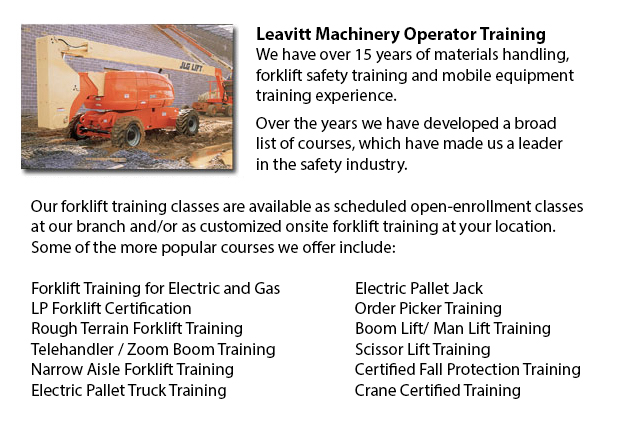
Toronto Aerial Boom Lift Training - Aerial Boom Lift Training is needed for any individual who operates, supervises or works in the vicinity of boom lifts. This particular kind of aerial lift or aerial work platform is for lifting people, materials and tools in projects requiring a long reach. They are generally used to access utility lines and other above ground job-sites. There are different kinds of aerial booms lifts, like for example extension boom lifts, cherry pickers and articulating boom lifts. There are two types of boom lift: "telescopic" and "knuckle".
Boom lift training is important and typically involves the fundamental operations, equipment and safety problems. Workers are needed while working with mobile machines to understand the safe work practices, rules and dangers. Training course materials provide an introduction to the applications, terms, concepts and skills required for workers to gain experience in boom lift operation. The material is aimed at safety experts, workers and equipment operators.
This training is cost-effective, educational and adaptive for your business. A safe and effective workplace can help a business attain overall high levels of production. Less workplace incidents occur in workplaces with strict safety guidelines. All equipment operators must be trained and evaluated. They require understanding of present safety measures. They should comprehend and follow rules set forth by their employer and local governing authorities.
Employers are required to ensure that their employees who operate aerial boom lifts get right training in their safe use. Operator certification is needed on each different kind of aerial machinery used in the workplace. Certifications are available for aerial work platforms, articulating booms, industrial forklift trucks, scissor lifts, etc. Employees who are fully trained work more efficiently and effectively compared to untrained personnel, who require more supervision. Right instruction and training saves resources in the long run.
Training is the best prevention for the primary causes of workplace fatalities: falls, electrocutions and collapses or tip overs. Other than training, the best way to avoid workplace accidents is to maintain and operate aerial work platforms based on the instructions of the manufacturer. Allow for the total weight of the worker, tools and materials when following load limits. Never override hydraulic, mechanical or electrical safety devices. Workers must be held securely inside the basket making use of a body harness or restraining belt with a lanyard attached. Do not move lift equipment while workers are on the elevated platform. Employees should take care not to position themselves between the joists or beams and basket rails in order to prevent being crushed. Energized overhead power lines should be at least 10 feet away from the lift machine. It is suggested that employees always assume power lines and wires might be energized, even if they seem to be insulated or are down. Set the brakes and utilize wheel chocks if working on an incline.
-
Toronto Wheel Loader Training
Toronto Wheel Loader Training - Normally, the different kinds of heavy equipment training are classed into 2 categories of machinery: those that have rubber tires and tracked vehicles. Tracked vehicles consist of items like for example excavators, cr... More -
Toronto Heavy Equipment Operator Training
Toronto Heavy Equipment Operator Training - Heavy equipment operator training facilities that provide good standards in the business, providing field performance tasks and added machinery training are really sought after training features. Students a... More -
Toronto Manlift Operator Certification
Toronto Manlift Operator Certification - We provide an aerial lift and scissor platform certification and training to empower the trainee with the general understanding and knowledge of the safe and efficient use of "Power Operated Mobile Work Platfo... More -
Toronto Aerial Boom Lift Ticket
Toronto Aerial Boom Lift Ticket - Aerial lifts can be utilized to accomplish a lot of unique duties done in hard to reach aerial spaces. Some of the odd jobs associated with this type of jack include performing regular preservation on structures with... More -
Toronto Heavy Equipment License
Toronto Heavy Equipment License - Obtaining a heavy equipment license is mandatory in order to operate these big industrial machinery. Certification could be acquired through a vocational school or private training. The license would enable the drive... More -
Skid Steer Loader Training in Toronto
A skid-steer loader is an engine powered equipment which consists of a small and rigid frame. It is outfitted together with lift arms that are utilized to connect to a large variety of labor saving tools and attachments. Typically, skid-steer loaders... More -
Toronto Aerial Lift Certification
Toronto Aerial Lift Certification - Aerial Lift Certification is for individuals who requires an in-depth understanding of aerial lift safety. Inspectors and operators, supervisors, maintenance workers and construction craftsmen should perform a cert... More -
Toronto Boom Lift Training
Toronto Boom Lift Training - Elevated work platforms, also called aerial platforms, allow workers to carry out tasks at heights which would otherwise be not reachable. There are different kinds of lifts intended for various site conditions and applic... More

Forklift Certification Toronto
TOLL FREE: 1-888-254-6157
Toronto, Ontario
forkliftcertificationtoronto.com
Email Us
About Us


